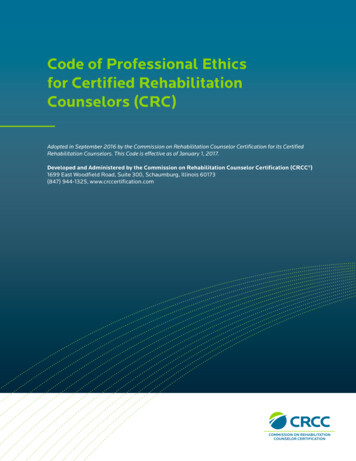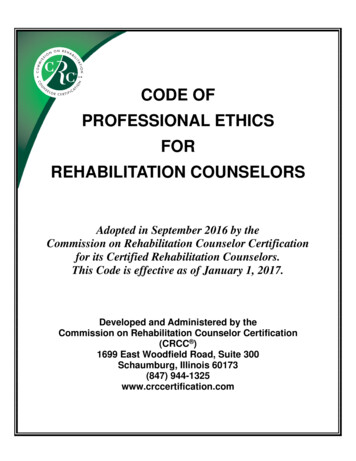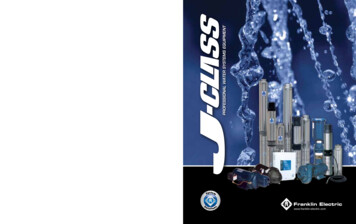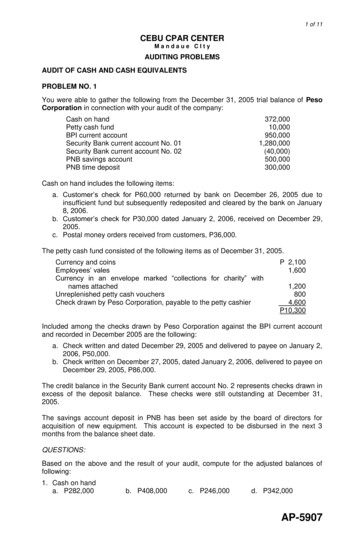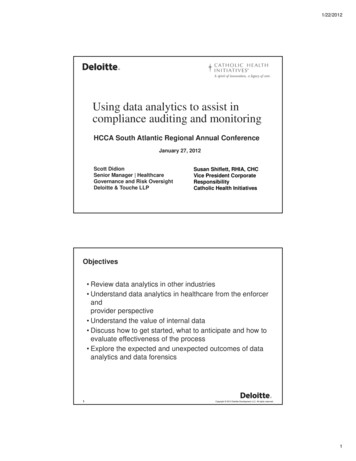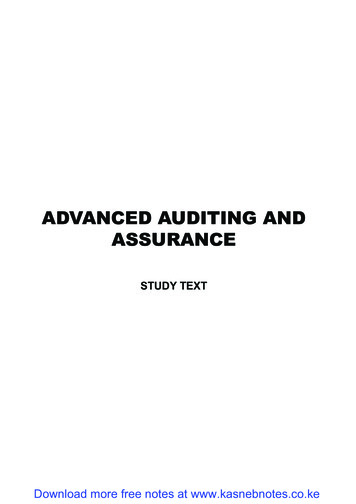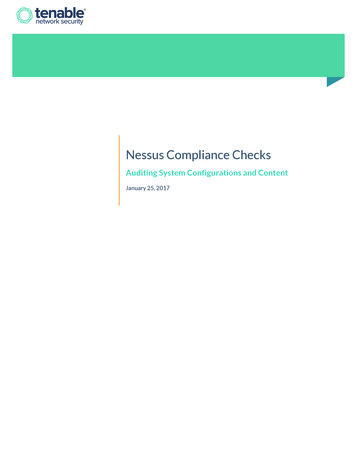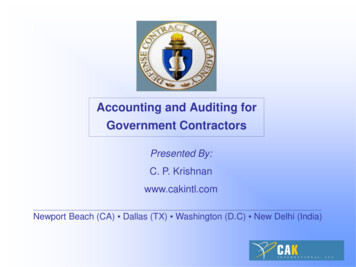
Transcription
AUDITING ANDPROFESSIONAL ETHICS ANDVALUES - PAPER 12SYLLABUS CHARTAuditing and Other Assurance Services - Paper 17Auditing and Professional Ethics and Values – Paper 12OVERALL AIMTo enable the learner understand procedures involved in planning and executing auditassignments as well as developing insights into professional values, ethics and attitudes.LEARNING OUTCOMESOn completion of this course, the learner should be able to:1.2.3.4.5.6.7.8.9.10.11.12.13.Define auditingExplain the need for and the nature of auditingDescribe the legal, regulatory and ethical environment within which audits areperformed in UgandaExplain the principles and procedures of auditingExplain how audit work is documented to provide sufficient appropriate audit evidenceExplain the design and testing of internal controlsDescribe risks of auditing in an information technology environment and the use ofcomputer-assisted audit techniquesExplain the role of internal auditingDescribe the performance of internal audit tasksExplain ethics in business and societyDemonstrate an understanding of public interests and fundamental ethical principlesDemonstrate an understanding of ethical standards of an accountantDiscuss ethical issues that an accountant needs to be mindful of128
14.15.16.17.18.Explain corporate governance issuesEvaluate the relationship between ethics and corporate governanceApply professional ethics, values and attitudes to work assignmentsIdentifying business opportunities and developing them into viable businessesExplain the challenges facing entrepreneurs and how to overcome themLEVEL OF ASSESSMENTThe examination will be focused mainly on knowledge, application and analysis of theprinciples acquired in auditing and professional ethics and values.EXAMINATIONS STRUCTUREThere will be a three hour examination made up sections A B and C. Section A will compriseof one compulsory question of 30 marks. Section B will comprise of four questions of 20marks each of which the candidate will be required to attempt any three. Section C willcomprise of two questions of 10 marks each, of which the candidate will be required toattempt one.DETAILED SYLLABUSPART 1 – AUDIT THEORYA. INTRODUCTION1.Auditing:(a) Meaning(b) Purpose/ objectives(c) Development2.(d) Auditing versus accountingThe changing role of auditing:(a) Ways in which audit objectives have changed over the years3.(b) Reasons for changes in audit objectives over the yearsThe information gap and stewardship:(a) The concepts of accountability, stewardship and agency4.(b) Responsibility over the financial statements of an entityAuditing postulates5.Concepts of auditing:(a) Auditor’s independence(b) Audit evidence(c) Materiality129
(d) True and fair6.(e) Disclosure of accounting policiesQualities of an auditor7.Types of audits:(a) Statutory, government, private(b) Internal audits(c) Other assurance assignments:(i) Forensic(ii) Value for money(iii) Audits relating to environmental and social issues(d) Advantages and disadvantages of an auditB. LEGAL, REGULATORY AND ETHICAL ENVIRONMENT1.Regulation and authorisation of auditors:(a) The roles and responsibilities of ICPAU(b) Rules governing registered and practising auditors2.(c) Reasons and mechanisms for the regulation of auditorsAppointment, rights and duties of company auditors:(a) Qualification for appointment as company auditors(b) Ways in which auditors may be appointed(c) Rights and duties of an auditor3.(d) Regulations governing the rights and duties of auditorsResignation and dismissal of auditors:(a) Circumstances under which an auditor may resign their appointment4.(b) Statutory regulations governing the rotation, removal and resignation of auditorsAuditing standards and guidelines:(a) The regulatory environment within which statutory audits take place(b) The importance, authority and applicability of International Standards onAuditing (ISAs)5.(c) The importance of auditing guidelines issued by ICPAUEthical requirements:(a) The fundamental principles of professional ethics of integrity, objectivity,professional competence and due care, confidentiality and professionalbehaviour(b) Safeguards against the threats to the fundamental principles130
(c) Importance of having the fundamental ethical principles(d) Responsibility of auditors with regard to their independence, conflicts of interestand confidentiality(e) Sources of, and enforcement mechanisms associated with, ICPAU’s code of6.ethicsAuditor’s liability:(a) Negligence: liability that may arise due to negligence(b) Liability under private and statutory audits(c) Criminal liability under the Companies Act(d) Minimisation of liabilities(e) Reference to be made to decided cases including the Caparo, the Al-Saudi7.Banque, London Oil Storage, Kingston Cotton Mill Ltd, Hedley Byrne casesRequirements of:(a) Accountants Act(b) The Companies Act(c) Insurance Act(d) Financial Institutions ActC. AUDIT PLANNING AND RISK ASSESSMENT1.Audit engagements:(a) Procedures of obtaining new audit work(b) Risks associated with the tendering process(c) Accepting new audit engagements:(i) The ethical, legal, practical and risk related issues to consider(ii) Procedures auditors should follow when accepting new audit work2.(iii) Importance, contents and format of an engagement letterAudit objectives:(a) Objective of an audit of financial statements(b) Procedures required in undertaking an audit of financial statements(c) Influences on the conduct of an audit3.(d) Risk-based approachPlanning and risk assessment(a) Audit planning:(i) Need for planning an audit(ii) Contents of the overall audit strategy and audit plan131
(iii) Relationship between the overall audit strategy and the audit plan(iv) Development and documentation of an audit plan(v) The planning process(b) Professional judgment and materiality:(i) Importance of professional skepticism(ii) The role of professional judgement(iii) Identification of potential misstatements(iv) Materiality and its importance(c) Risk assessment:(i) Meaning of audit risk(ii) Audit risks at the financial statement and assertion levels(iii) Auditor’s response to identified risks(iv) Determination of materiality levels from financial information(v) Identification and assessment of risk of material misstatements(vi) Assessment of risks due to fraud(vii) Effect of fraud and material misstatements on audit strategy and work tobe done(d) Understanding the entity and its environment:(i) Obtaining an initial understanding of the entity and its environment(ii) Application of preliminary analytical procedures(iii) Ratios used in analytical procedures(iv) Interim audits: Purpose Procedures Effect on the final audit(e) Audit documentation:(i) Nature and purpose(ii) Form, content and extent(iii) Contents of working papers and supporting documents(iv) Procedures of ensuring the safety and retention of working papers andother audit documents(v) Current and permanent filesD. INTERNAL CONTROLS1.Internal control systems:(a) Meaning:(i) Control environment(ii) Control risks132
(iii) Tests of control(b) Elements of an internal control system(c) Assessment the internal control systems, types and policies of a givenorganisation(d) Importance and limitations of an internal control system(e) Responsibility of management in designing and implementing an internalcontrol system(f)Internal control procedures and control activities(g) Need for an auditor to obtain an understanding of internal control activitiesrelevant to the audit(h) Internal controls over:(i) Sales revenue(ii) Purchases(iii) Inventory(iv) Revenue and capital expenditures(v) Payroll2.(vi) Cash and bankAudit of internal control systems:(a) Control objectives, procedures and tests of control in relation to the differentsystems of an organisation(b) Techniques of evaluating an internal control system3.(c) Modification of audit strategy and plan following the results of tests of controlCompliance tests:(a) Tests of control versus substantive procedures(b) Importance of internal controls to auditors(c) Tests of control suitable for inclusion in audit working papers4.(d) Weaknesses in internal control systems:(i) Identification(ii) Limitation of extent of reliance on internal control systems by the auditorThe effects on risk assessment:(a) Management’s risk assessment process with reference to internal controlcomponents(b) Limitations of internal control components in the context of fraud and error(c) Reporting of internal control weaknesses and recommendations to overcomethemE. AUDITING IN AN INFORMATION TECHNOLOGY (IT) ENVIRONMENT(a) Risks and challenges of auditing in an IT environment133
(b) Application controls and general IT controls(c) Use of computer-assisted audit techniques(d) Key aspects of computer auditingF.AUDIT EVIDENCE AND SAMPLING1.Audit sampling:(a) Considerations and process of designing audit samples(b) Determination of sample sizes and selection of items for sampling; bases/approaches to selecting samples (statistical, non- statistical)(c) Circumstances when audit sampling is not appropriate2.(d) Sampling riskAudit evidence:(a) Types(b) Sources(c) Techniques of obtaining audit evidence(d) Sufficiency and appropriateness(e) Reliability(f)Limitations on the quality and quantity(g) Consistency of audit evidence:(i) Meaning and the usefulness(ii) Need for consistency of audit evidence(iii) Procedures used in obtaining consistent audit evidence3.(h) Procedures/ methods/ techniques of obtaining evidenceAnalytical procedures:(a) Meaning(b) Use of substantive analytical procedures in an audit4.(c) How results of analytical procedures are investigatedExternal confirmations:(a) Importance of external confirmation procedures(b) How external confirmations are performed(c) Evaluation of external confirmationsG. AUDIT PROCEDURES1.Statement of profit or loss and other comprehensive income audit(a) The financial statements assertions:(i) Occurrence134
ication(b) Matters relating to revenue and expenses recognition:(i) Materiality(ii) Risk(iii) Relevant accounting standards(iv) Audit evidence(c) Procedures for verifying revenue and expenditure(d) Audit evidence in respect of the audit of income statement items2.(e) The audit of a payrollBalance sheet/ statement of financial position audit:(a) The financial statements assertions:(i) Existence(ii) Rights and obligations(iii) Completeness(iv) Valuation and allocation(b) Identification of balance sheet items and the respective implications in an auditreport(c) Factors in the timing of the audit of each item in a balance sheet(d) Audit evidence in respect of the audit of balance sheet items(e) Post balance sheet review and its importance in an audit(f)3.Review of events after the reporting period(g) Analytical procedures in auditing statement of financial position itemsAudit opinion on financial statements:(a) Use of audit evidence to form an opinion(b) Types of opinions(c) Evaluation of external confirmationsH. INTERNAL AUDIT1.Role of internal auditing:(a) Scope(b) Limitations135
(c) Role of an internal auditor in the management of an organisation(d) Use of the internal professional practices framework in internal auditing2.External versus internal auditing:(a) Responsibilities in the detection and prevention of fraud and error(b) Roles regarding planning and collection of audit evidence3.(c) Internal and external auditor’s reportsPerforming an Internal Audit Assignment:(a) Nature of internal audit work(b) Planning internal audit assignments(c) Conducting an internal audit assignment(d) Communication of the results of internal audit assignments(e) The format and content of audit review reports4.(f) Recommendations to management and those charged with governanceDevelopments in internal auditing:(a) Nature and purpose of internal audit assignments including value for money,information technology, investigation(b) Operational internal audit assignments (procurement, marketing, treasury andhuman resources management)(c) Advantages and disadvantages of outsourcing the internal audit functionPART II -PROFESSIONAL ETHICS AND VALUESA. INTRODUCTION1.Meaning of ‘ethics’ and ‘values’2.Nature of ethics3.Philosophical versus professional approaches to ethics4.Ethical objectives of an organisation and the accountancy professionB. WORKPLACE ETHICS1.Meaning2.Ethical behaviour at work:(a) Individual standards and values(b) Manager’s and co-workers’ influence(c) Codes of ethics and compliance requirements136
(d) Discrimination3.(e) HarassmentImportance of ethical behaviour at the workplace4.Management of ethical behaviour at the workplaceC. ETHICS IN BUSINESS1.Ethical principles in businesses2.Nature, purpose of ethics and morals for organisational interests3.Sources of ethical standards:(a) The Utilitarian approach(b) The rights approach (the deontological approach)(c) The fairness of justice approach(d) The common good approach4.(e) The virtue approachTypes of business ethical issues5.Enforcement of corporate policy and functional area ethics6.Areas covered by corporate codes of ethics7.Concept of ethical dilemma in businesses:(a) Business relationships(b) Conflicts of interest(c) Fairness and honesty8.(d) CommunicationsBenefits of adhering to business ethics:(a) Improved society(b) Change management(c) Strong teamwork(d) Productivity(e) Employee growth(f)Management of the human resources(g) Avoidance of criminal acts(h) Manage values associated with quality management, strategic planning anddiversity management(i)Promotion of strong public image137
D. BUSINESS AND ENVIRONMENTAL ETHICS1.Concept of sustainable development2.Challenges of pollution and resource depletion3.Interrelationships and interdependence of ecological systems4.Eco-friendly business practicesE. PUBLIC INTEREST1.Meaning2.Composition of the public3.Negative and positive outcomes (costs and benefits) of public interest4.Decisions/ actions taken in the public int
2. Audit objectives: (a) Objective of an audit of financial statements (b) Procedures required in undertaking an audit of financial statements (c) Influences on the conduct of an audit (d) Risk-based approach 3. Planning and risk assessment (a) Audit planning: (i) Need for planning an audit (ii) Contents of the overall audit strategy and audit plan

